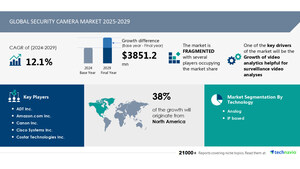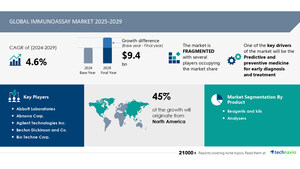NEW YORK, July 19, 2024 /PRNewswire/ -- The global social robots market size is estimated to grow by USD 14.23 billion from 2024-2028, according to Technavio. The market is estimated to grow at a CAGR of 41.29% during the forecast period. Rise in adoption of social robots for elder population is driving market growth, with a trend towards increasing focus on enhancing battery life. However, high cost of owning social robots poses a challenge. Key market players include Alphabet Inc., BLUE FROG ROBOTICS SAS, Diligent Robotics Inc., Engineered Arts Ltd., Furhat Robotics AB, Haapie SAS, Hitachi Ltd., Hyundai Motor Co., Intuition Robotics Ltd., Knightscope Inc., Kompai Robotics, Navel robotics GmbH, Nippon Telegraph and Telephone Corp., PAL Robotics, Relay Robotics Inc., SoftBank Group Corp., Sony Group Corp., Toyota Motor Corp., UBTECH Robotics Inc., and Yukai Engineering Inc..
Get a detailed analysis on regions, market segments, customer landscape, and companies - Click for the snapshot of this report
Forecast period |
2024-2028 |
Base Year |
2023 |
Historic Data |
2018 - 2022 |
Segment Covered |
Component (Hardware, Software, and Services), End-user (Healthcare, Media and entertainment, Education, Retail, and Others), and Geography (APAC, North America, Europe, Middle East and Africa, and South America) |
Region Covered |
APAC, North America, Europe, Middle East and Africa, and South America |
Key companies profiled |
Alphabet Inc., BLUE FROG ROBOTICS SAS, Diligent Robotics Inc., Engineered Arts Ltd., Furhat Robotics AB, Haapie SAS, Hitachi Ltd., Hyundai Motor Co., Intuition Robotics Ltd., Knightscope Inc., Kompai Robotics, Navel robotics GmbH, Nippon Telegraph and Telephone Corp., PAL Robotics, Relay Robotics Inc., SoftBank Group Corp., Sony Group Corp., Toyota Motor Corp., UBTECH Robotics Inc., and Yukai Engineering Inc. |
Key Market Trends Fueling Growth
The battery life of social robots is a significant challenge for manufacturers, as continuous use necessitates frequent charging. Research and development teams are addressing this issue by creating longer-lasting batteries. However, battery size also restricts robot design, occupying approximately one-fifth of the available space. University of Michigan researchers are developing biomorphic batteries, providing up to 72 times more energy for robots. Meanwhile, Bristol Robotics Laboratory's self-powering robot, EcoBot-II, converts insect biomass into energy using onboard microbial fuel cells. These advancements in battery technology are expected to boost R&D in robotic batteries, contributing to the growth of the social robots market during the forecast period.
The Social Robots Market is experiencing significant growth as businesses seek to enhance teaching, learning processes, and customer experience through advanced technologies. Peer learners and cognitive outcomes are key trends, with robots used for personalized tutoring and therapy sessions. Interactive panels, tablets, projectors, video conferencing, and automation are essential hardware components. AI technologies, including machine learning, facial recognition, and gesture detection, are driving cognitive and affective outcomes. Robots offer empathy and emotional support, making them ideal for elderly care and therapy. In hospitality, banking, and customer service, they provide personalized services, improving user experience. Labor shortages in various industries are driving efficiency and support through automation. Smart home technology, including smart thermostats, lighting systems, and security cameras, is integrating robots for enhanced functionality. Technical support is available for hardware and software issues. Customization and customized services are essential for business success in this market.
Discover 360° analysis of this market. For complete information, schedule your consultation- Book Here!
Market Challenges
- The global social robots market faces a significant challenge due to the high cost of manufacturing these advanced devices. The integration of advanced software and sensors for image processing and independent decision-making increases production expenses. This high cost is a barrier for consumers in emerging economies, such as India, to purchase social robots. Vendors continue to invest in research and development, introducing new and advanced models with advanced technologies. While these innovations enhance the functionality of social robots, they also contribute to the rising costs. This price point may hinder the adoption of social robots among middle-class consumers in developing countries, potentially hindering market growth during the forecast period.
- The Social Robots Market is experiencing significant growth due to the integration of advanced technologies such as Artificial Intelligence (AI) and Machine Learning (ML) in rehabilitation robots, robot toys, and social robots. Designers and neuroscientists use psychological insights and algorithms to create robots with faces, emotions, voices, and behavior that mimic humans. These robots use sensors and cameras for navigation and human observations, providing personalized customer experiences. Budgetary allocations for technology development in healthcare and educational organizations, research funding programs, and start-ups are driving the market forward. Robotics, IoT, Big Data, and 5G technology are also playing crucial roles. Challenges include ensuring fair behavior, mobility assistive devices for disabilities, and demonstration of behavior in various environments, including industrial, commercial, and residential spaces. Path planning systems and human-robot interaction are essential for successful implementation.
For more insights on driver and challenges - Download a Sample Report
Segment Overview
This social robots market report extensively covers market segmentation by
- Component
- 1.1 Hardware
- 1.2 Software
- 1.3 Services
- End-user
- 2.1 Healthcare
- 2.2 Media and entertainment
- 2.3 Education
- 2.4 Retail
- 2.5 Others
- Geography
- 3.1 APAC
- 3.2 North America
- 3.3 Europe
- 3.4 Middle East and Africa
- 3.5 South America
1.1 Hardware- The social robots market encompasses the hardware segment, which involves components like processors, actuators, sensors, cameras, robotic arms, controllers, and power systems. The miniaturization of electronic components, such as sensors and actuators, along with advancements in batteries and control systems, fuel the demand for sophisticated social robots. Advanced cameras, such as LIDAR technology-integrated systems, are essential for social robots' vision systems, enabling functions like object detection and facial recognition. Vendors prioritize investing in advanced technologies, including microprocessors, to boost social robots' cognitive abilities. Qualcomm Inc.'s Robotics RB3 platform, featuring AI engines and heterogeneous computing, is an example of such advancements. As social robots' functionalities evolve, their adoption in various applications increases, driving the demand for the hardware segment in the global social robots market.
For more information on market segmentation with geographical analysis including forecast (2024-2028) and historic data (2018 - 2022) - Download a Sample Report
Learn and explore more about Technavio's in-depth research reports
The global market for humanoid robots, logistics robots, and autonomous mobile robots is experiencing rapid growth driven by advancements in AI and automation technologies. Humanoid robots are revolutionizing industries with their human-like capabilities, while logistics robots streamline warehouse operations, enhancing efficiency. Autonomous mobile robots are transforming logistics with their ability to navigate complex environments independently. These markets are poised for expansion as businesses seek innovative solutions to optimize operations and meet rising consumer demands for faster and more efficient services.
Research Analysis
Social robots are advanced technologies revolutionizing various industries, including robotics and automation, medical industries, autism therapy, workforces, and labor. These robots are designed to navigate social environments, utilizing sensors and cameras for perception and a path-planning system for mobility. The integration of AI technologies, such as natural language processing, facial recognition, and gesture detection, enhances their ability to interact with users. In the medical field, social robots offer companionship and emotional support for the elderly, while in education, they facilitate classroom interaction for students with disabilities. Neuroscientific and psychological insights inform the design of social robots, ensuring user experience is optimized. With the ongoing digitization, social robots are set to become an integral part of our lives, providing personalized services and enhancing human capabilities.
Market Research Overview
The Social Robots Market is experiencing significant growth as robotics and automation continue to revolutionize various industries. In the medical field, social robots are being used for autism therapy, rehabilitation, and elder care. These robots are designed with advanced technologies such as artificial intelligence (AI), sensors, and cameras to navigate social environments, understand people's needs, and demonstrate fair behavior. In the education sector, social robots are being used to enhance classroom interaction for students with disabilities, improve cognitive and affective outcomes, and provide personalized tutoring. The use of facial expressions, gestures, and empathy in social robots is making therapy sessions more effective and engaging. The market is also being driven by budgetary allocations, technology development, and research funding programs in healthcare and educational organizations. Start-ups and AI technologies such as machine learning, IoT, big data, and 5G technology are also contributing to the growth of the social robots market in industrial, commercial, and residential spaces. The market is expected to continue growing as social robots become more integrated into our daily lives, providing personalized customer experiences, automating customer service, and improving the quality of life for individuals with disabilities and the aging population.
Table of Contents:
1 Executive Summary
2 Market Landscape
3 Market Sizing
4 Historic Market Size
5 Five Forces Analysis
6 Market Segmentation
- Component
- Hardware
- Software
- Services
- End-user
- Healthcare
- Media And Entertainment
- Education
- Retail
- Others
- Geography
- APAC
- North America
- Europe
- Middle East And Africa
- South America
7 Customer Landscape
8 Geographic Landscape
9 Drivers, Challenges, and Trends
10 Company Landscape
11 Company Analysis
12 Appendix
About Technavio
Technavio is a leading global technology research and advisory company. Their research and analysis focuses on emerging market trends and provides actionable insights to help businesses identify market opportunities and develop effective strategies to optimize their market positions.
With over 500 specialized analysts, Technavio's report library consists of more than 17,000 reports and counting, covering 800 technologies, spanning across 50 countries. Their client base consists of enterprises of all sizes, including more than 100 Fortune 500 companies. This growing client base relies on Technavio's comprehensive coverage, extensive research, and actionable market insights to identify opportunities in existing and potential markets and assess their competitive positions within changing market scenarios.
Contacts
Technavio Research
Jesse Maida
Media & Marketing Executive
US: +1 844 364 1100
UK: +44 203 893 3200
Email: [email protected]
Website: www.technavio.com/
SOURCE Technavio

WANT YOUR COMPANY'S NEWS FEATURED ON PRNEWSWIRE.COM?
Newsrooms &
Influencers
Digital Media
Outlets
Journalists
Opted In





Share this article